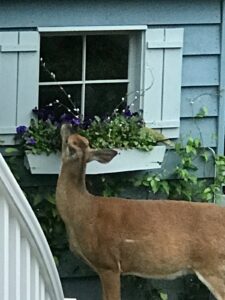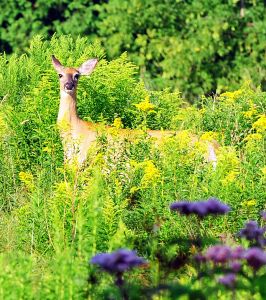 It’s not just tough winters that New Jersey faces, but also hungry deer that help themselves to household gardens. Fortunately, there are deer-resistant plants that most deer will look past, which means you can finally garden in peace. Remember that not all deer are the same, and some may still help themselves to a bite or two of even deer-resistant plants.
It’s not just tough winters that New Jersey faces, but also hungry deer that help themselves to household gardens. Fortunately, there are deer-resistant plants that most deer will look past, which means you can finally garden in peace. Remember that not all deer are the same, and some may still help themselves to a bite or two of even deer-resistant plants.
Bee Balm – Bee balms attract hummingbirds and butterflies, and they have a long life over the summer months. These perennials have brightly colored flowers and are a real treat for the garden, and deer and rabbits leave them alone for the most part.
Brunnera – These plants last all the way to frost, and although they may not be super popular, they’re hearty plants to add to any garden. Brunneras bloom in the spring and share clusters of sky blue flowers that will last until fall.
Catmint – Catmints are known for their beautiful clusters of lavender flowers that bloom in the summer and last until fall. They’re versatile, reliable and last a long time, plus the catmint plant has a lovely smell to it.
Golden Marguerite – These timeless flowers are a great way to fill the garden and add color. They look just like yellow daisies and are also able to be cut, allowing you to bring some outdoor cheer into your home.
Japanese Painted Fern – Ferns are always a great choice, as deer tend to pass over most of them. What makes this fern an excellent choice is that it offers color for gardens all season long and is slow to spread.
Lily-of-the-Valley – These sweet little flowers are low maintenance and bloom during the springtime. These flowers are actually poisonous to deer, and they will spread quickly, which is great if you’re looking for a quick and pretty ground cover.
Sea Holly – Sea holly is something that both deer and rabbits stay away from, and it’s also resilient and does well in extreme conditions. This is a great perk for the hot and humid summers and cold winters of the Northeast.
Turtlehead – This flower won’t be a secret for long, as it’s pretty and takes the shape of, well, a turtle head. The flower blooms in the late summer or early fall and leaves behind pink and white blossoms.
Virginia Bluebells – These wildflowers bloom in the spring and go dormant in the summer. While it may not bring much color for very long, the short bloom is well worth the wait, and the deer won’t eat the bluebells.

